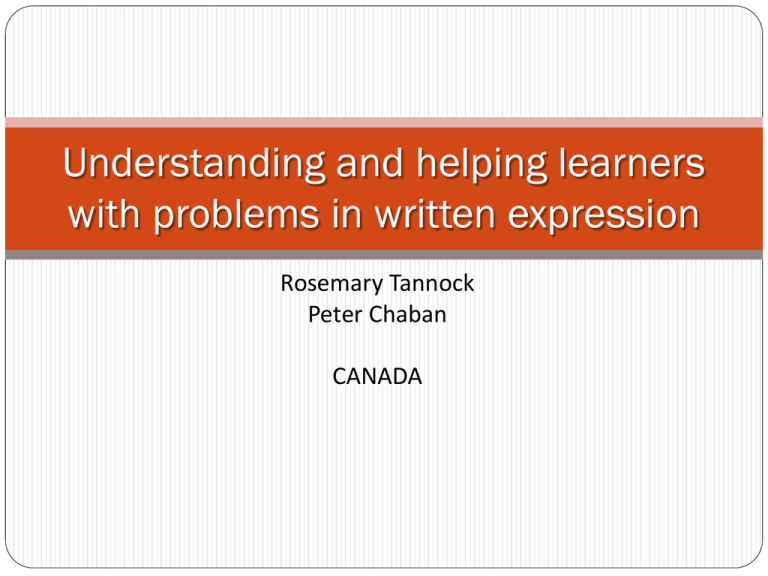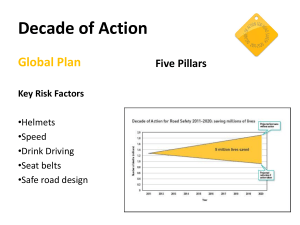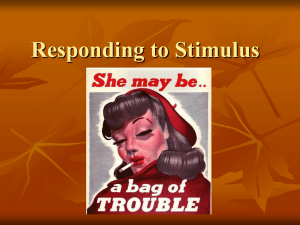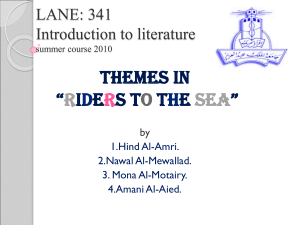Understanding and helping learners with problems in
advertisement

Understanding and helping learners with problems in written expression Rosemary Tannock Peter Chaban CANADA Why worry about written expression? Communication in writing is critical for academic success & everyday functioning Educators often rely on the learner’s written product to assess their learning/knowledge – across the curriculum Inclusion in youth culture (text messaging) Adult life requires basic writing skills Signing name Demands of the workplace Learning to Talk is Different Than Learning to Write Speaking Social, informal Listener is present a social interaction between cooperative, partners. Co-construct meaning in the here-and-now Writing Solitary, formalized Reader is absent A solitary activity in which the writer aims to communicate his/her intended meaning Reader reconstructs meaning- later Writing is not the mirror image of reading Competent readers do not necessarily become competent writers. In addition to recognizing letters automatically, one must learn to produce letters automatically. Learning to spell is more complicated than learning to read. There are many more speech- to- sound variations than letter-to-sound variations. Putting ideas in writing is a more complex task than putting ideas into words. Children with difficulties in speech and language are at higher risk for writing disabilities. Writing is not the mirror image of reading Reading is Language by Eye Writing is Language by Hand Virginia Berninger et al (2002) J Learning Disabilities Two major components of writing Transcription Composition or Text Generation • Handwriting • Spelling • Punctuation • Capitalization • Grammar • Planning • Production • Editing/revision Common Behaviors of Learners with Writing Difficulties Lack of any writing behavior – blank page! Slow & effortful transcription Struggle with mechanics of writing – slow formation of letters, slow & poor spelling, lack of capitalization, punctuation Minimal or no planning Short sentences; strings of unrelated sentences, not in logical order Minimal or no attempts at revision; revision tends focus on correcting mechanical errors Key research findings Fluent & automatic writing, particularly alphabet letter writing, is a fundamental building block of writing competence Best predictor of length & quality of composition - from elementary school through college Graham & Harris (1997) School Psychology Review; Conolly et al (2006) Developmental Neuropsychology Writing progress using the Play Plan Vygotskyan-based preschool program improves cognitive control (Diamond et al, Science, 2007: 318: 1387-1388) Tools of the Mind (Bodrova & Leong) • Study of 140 preschoolers randomly assigned to “Tools” or “Balanced Literacy” – Low-income, urban district – 18 classrooms (plus 3/program in year 2) • 40 activities promoting executive function (EF) – self-regulatory self-talk; dramatic play; memory & attention scaffolds • Children in Tools showed marked improvements in EF measures & standardized academic measures EFFECTIVE INSTRUCTION IN LETTER WRITING Berninger (2008) Handwriting should be taught explicitly, not incidentally. Keyboarding Evidence-Based Approach & (improves automaticity of legible letters) Technology 5- 10 min lessons, followed by opportunity to use handwriting in a meaningful manner Practice each letter by studying number arrow cues Covering the letter, then writing it from memory Practice writing letters within words TEACHING TIPS: Monitor progress in speed of letter writing… •Alphabet Letter Writing Probe • On lined paper, ask child to print (or in cursive writing) the letters of the alphabet in order as quickly as possible; How many letters in 13 sec? Evidence-Based Intervention for Writing All areas of written language should be addressed within the same instructional session. Handwriting, spelling, and composition should be taught together, and instruction should be explicit. Keep in mind the range of skills required for writing text Two major components of writing Transcription Composition or Text Generation • Handwriting • Spelling • Punctuation • Capitalization • Grammar • Planning • Production • Editing/revision Skill domains involved in writing Domain Component skills GRAPHOMOTOR Form letters; pencil grip; controlled finger/arm movement ATTENTION Sustained focused attention on tasks VISUOSPATIAL Keeping within lines; spacing, organization on line/page LANGUAGE Spelling, word order, sentence structure, vocabulary, WORKING MEMORY Hold word in mind while transcribing into written word; Hold ideas in mind during transcription & text generation What is working memory ? A “mental workbench” (Klingberg, 2009) Function of the brain that helps us temporarily hold information in mind - just for a few seconds - to manipulate it and use it to solve a problem or task. That is, for thinking! Strategies for Organization to reduce working memory demand • Chunk information Prior knowledge (repeat key information) Cue (signal what’s important) • Categorize (part-whole relationship by membership) • Sequence (part-whole relationship by size) • Learned memory strategies – mnemonics, visualization, subjective associations Glass,Holyoak, Santa (1979) Language’s organizational strategies Language is made of: 1. Sounds which form……… 2. Words which result in……….. 3. Meaning within…….. 4.Context. Traditional Grammar “how words & their parts combine to make meaning” Sentence- full unit of meaning Clause complex- consists of one or more clauses Clause- consists of one or more phrases of which one must be a verb phrase Phrase- consists of one or more words Words – consists of one or more morphemes Morphemes – minimal unit of meaning Point of Instruction Vocabulary Grammar Discourse Genre Academic language Meaning@ the sentence level S. Africa will win the World Cup someday. ( agent declarative theme process Result/Circumstance(time) judgment rheme Meaning • At the clause/sentence level: Meaning as what we represent: -participants, process, circumstance Meaning as how we feel: -mood and modality Meaning as we organize text: -theme & rheme (cueing focus of importance) Text organizing meaning -theme comes at the beginning of a clause structure - theme also organizes the text beyond the sentence - It is everything up to the verb phrase The Theme is often the subject of the clause. But, conjunctions can be part of the theme. For sure, interpersonal elements can be part of the theme. In some cases, prepositional phrases are part of the theme. M.Schleppegrell (2004) Text Organization for Old & New information theme/rheme – natural language mechanism of: a) Prior knowledge or old information b) Cueing new information 1. Inclusive teachers 2. He or she 3. They also need to understand all children. must be fair and reasonable. need to teach at a sensible pace. 4. need to lecture with a clear voice. As well, these educators 5. And, if the children 6. they theme have been good all week, should end with fun activities. rheme Thematic Progression Theme 1 rheme1 Inclusive teachers need to understand all children. Theme 2 rheme 2 He or she must be fair and reasonable. They also need to teach at a sensible pace. Theme 3 rheme 3 Theme 4 rheme 4 As well, these educators Theme 5 rheme 5 And, if the children have been good all week, Theme 6 rheme 6 they should end with fun activities. need to lecture with a clear voice. Activity 1. Dogs are animals. 2. Dogs can be pets. 3. These animals can be very special. Activity 1. Dogs /are animals. 2. Dogs /can be pets. 3. These animals /can be very special. Topic : write about an animal • • • • • • Dogs Dogs Pets Hard work It We all are animals. can be pets. can be hard work. can be good for you. teaches you to care for others. should take care of each other. Edited for style Dogs are animals, but they can also be a pet. As pets, they can be hard work. This can be good for you because it teaches you to take care of someone else. We should all learn to care for others. 2. Cohesion Halliday & Hasan (1976) • Grammar at the discourse level: Repetition & signaling to draw connections between sentences: 1.Reference (personal & demonstrative pronouns) 2.Word sets (synonyms & related words) 3.Conjunctions – linking (and, or,) - logical (if, then, because) 1. 2. 3. 4. 5. 6. Inclusive teachers He or she They also As well, educators And, if the children this theme need to understand all children. must be fair and reasonable. need to teach at a sensible pace. need to lecture with a clear voice. have been good all week, should end with fun activities. rheme Writing concerns for ADHD/LD student • Structuring concepts & information into organization patterns • Incorporating reading, research, analysis & synthesis into text • Editing for errors • Sustaining focus on task at hand AND Just getting started!!!!!!! Traditional solution (accommodations) • Ignore spelling and grammar until editing • Use visual supports, such as paragraph & essay format templates • Use technology or tutor to address spelling and grammar Teaching the writing process • Planning – research & organizing ideas • Production – writing • Editing – for style Teaching them to use ……. 1. Textual strategies (new & given information) 2. Teach about cohesion Topic : write about an animal • • • • • • Dogs Dogs Pets Hard work It We all are animals. can be pets. can be hard work. can be good for you. teaches you to care for others. should take care of each other. Edited for style Dogs are animals, but they can also be a pet. As pets, they can be hard work. This can be good for you because it teaches you to take care of someone else. We should all learn to care for others. Evidence-Based Intervention for Writing • All areas of written language should be addressed within the same instructional session. • Handwriting, spelling, and composition should be taught together, and instruction should be explicit. • Keep in mind the range of skills required for writing text









